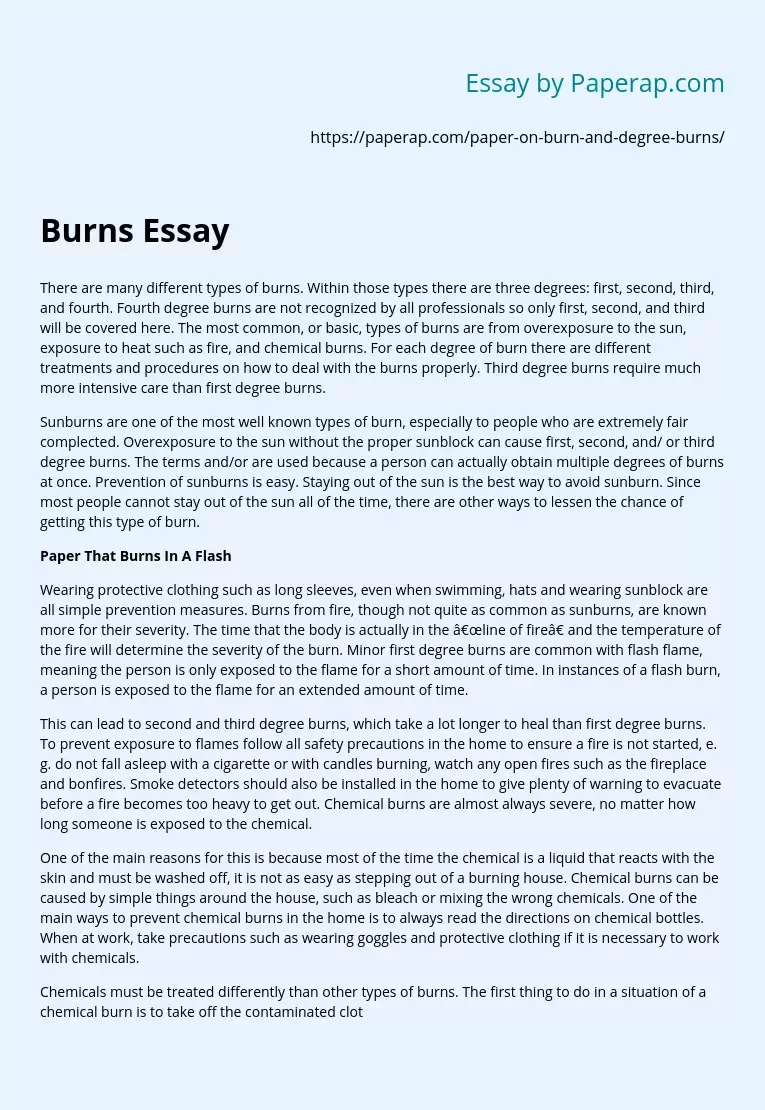There are many different types of burns. Within those types there are three degrees: first, second, third, and fourth. Fourth degree burns are not recognized by all professionals so only first, second, and third will be covered here. The most common, or basic, types of burns are from overexposure to the sun, exposure to heat such as fire, and chemical burns. For each degree of burn there are different treatments and procedures on how to deal with the burns properly. Third degree burns require much more intensive care than first degree burns.
Sunburns are one of the most well known types of burn, especially to people who are extremely fair complected. Overexposure to the sun without the proper sunblock can cause first, second, and/ or third degree burns. The terms and/or are used because a person can actually obtain multiple degrees of burns at once. Prevention of sunburns is easy. Staying out of the sun is the best way to avoid sunburn.
Since most people cannot stay out of the sun all of the time, there are other ways to lessen the chance of getting this type of burn.
Paper That Burns In A Flash
Wearing protective clothing such as long sleeves, even when swimming, hats and wearing sunblock are all simple prevention measures. Burns from fire, though not quite as common as sunburns, are known more for their severity. The time that the body is actually in the “line of fire” and the temperature of the fire will determine the severity of the burn.
Minor first degree burns are common with flash flame, meaning the person is only exposed to the flame for a short amount of time. In instances of a flash burn, a person is exposed to the flame for an extended amount of time.
This can lead to second and third degree burns, which take a lot longer to heal than first degree burns. To prevent exposure to flames follow all safety precautions in the home to ensure a fire is not started, e. g. do not fall asleep with a cigarette or with candles burning, watch any open fires such as the fireplace and bonfires. Smoke detectors should also be installed in the home to give plenty of warning to evacuate before a fire becomes too heavy to get out. Chemical burns are almost always severe, no matter how long someone is exposed to the chemical.
One of the main reasons for this is because most of the time the chemical is a liquid that reacts with the skin and must be washed off, it is not as easy as stepping out of a burning house. Chemical burns can be caused by simple things around the house, such as bleach or mixing the wrong chemicals. One of the main ways to prevent chemical burns in the home is to always read the directions on chemical bottles. When at work, take precautions such as wearing goggles and protective clothing if it is necessary to work with chemicals.
Chemicals must be treated differently than other types of burns. The first thing to do in a situation of a chemical burn is to take off the contaminated clothing to slow down the spread of the chemical. In some cases of chemical burns irrigating with water is a tremendous help in slowing the spread of the chemical. Unfortunately, water does not always help. Depending on the chemical, it is better to irrigate with mineral oil. This way the oil does not react with the chemical. First degree burns are the simplest to treat.
Flushing a first degree burn with cool water will bring relief to an injured person. It cools down the skin. The sooner this is done, the better. There is no scarring from a first degree burn, only possible discoloration. It only takes a couple of days to heal a first degree burn, the shortest amount of time of all of the burns. With a second degree burn it is sometimes necessary to take a mild pain reliever such as tylenol. Elevating the burned area will also help with the pain and blood flow. A cream can also be put on the affected area to decrease the recovery time.
It takes about three to four weeks to heal a second degree burn. Second degree burns may cause a little bit of scarring, but it is usually not much if treated properly. Third degree burns are the hardest to treat. These often require skin grafts after the dead skin is removed. Heavy pain relievers and fluids are required, as well. It can takes years of surgeries and therapy to fully heal someone of third degree burns. Even with a lot of surgeries there is no way to completely get rid of the scarring.
This is one of the reasons that people may need therapy, to cope with the way they look and how people perceive them after an accident. It is easy to see why prevention is a much better option than treatment. Though it may seem tedious and time consuming to ensure that burns are prevented, it will help much more in the long run. It is much cheaper to buy a smoke detector than to pay thousands of dollars in medical expenses. Works Cited “Burn Center Team. ” – Wake Forest Baptist Health. N. p. , n. d. Web. 28 Nov. 2013.. “Burn Services Provided at UNM Hospitals Burn Center.
” Burn Services Provided at UNMHospitals Burn Center. N. p. , n. d. Web. 28 Nov. 2013.. “Health Facts For You. ” UW Health. N. p. , n. d. Web. 30 Nov. 2013.. Price L, Milner S. The totality of burn care. Trauma [serial online]. January 2013;15(1):16-28. Available from: Academic Search Premier, Ipswich, MA. Accessed November 26, 2013. Rowley-Conwy G. Management of major burns in the emergency department. Nursing Standard[serial online]. April 17, 2013;27(33):62-68. Available from: Academic Search Premier,Ipswich, MA. Accessed November 26, 2013.
Burns Degrees and Treatment Essay. (2019, Dec 05). Retrieved from https://paperap.com/paper-on-burn-and-degree-burns/

